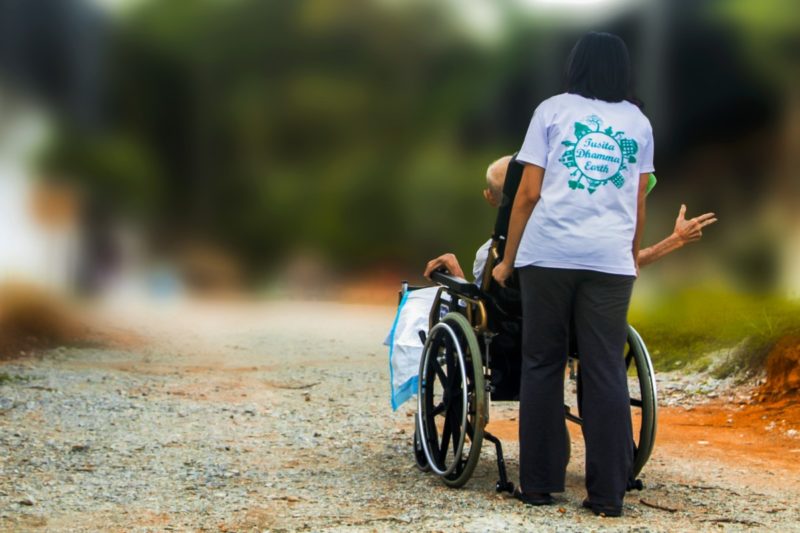If you have a loved one who is using a wheelchair, then you need to know how to transfer a paralyzed patient from a wheelchair to bed.
Furthermore, you need to know about the different transfer methods to ensure the safety of the patient.

Don’t get nervous, we are here to help!
So, without further ado, let’s start.
In this article, we’ll talk about the preparation as well as the steps in transferring a paralyzed patient from a wheelchair to bed.
Preparation To Transfer A Paralyzed Patient From A Wheelchair To Bed
Before you begin, you need to prepare yourself.
Think through the steps first and call for help if necessary.
Remember that if you fail to support the weight of the patient, you may end up hurting the patient and yourself.
You have to ensure that there are no loose rugs along the way to avoid slipping incidents.
Consider putting a pair of non-skid shoes or socks on the feet of the patient in case the surface is a bit slippery.
Also, explain the steps that you are about to take to your patient.
Then, position the wheelchair near you and the bed.
Ensure to put on the brakes. Furthermore, the footrests must be moved out of your way.
Also, move out the armrest of the wheelchair on the side to make it easier for you.
Ways To Transfer A Paralyzed Patient From A Wheelchair To Bed
So, how to transfer a paralyzed patient from a wheelchair to bed?
In this section, we will provide two different techniques that you can use in moving the patient.
Method #1. Stand And Pivot
Take note that the first technique assumes that the patient is capable of standing in one leg.
So if your patient cannot stand in one leg, consider the lift to transfer technique.
Now, let us proceed with the steps.
Step #1. Getting into the right position
The wheelchair must be positioned at an angle of 30 degrees to the bed.
Secure the transfer harness or the gait belt onto the waist of the user.
Make sure that the belt is only a snug fit. It must not be too tight.
Also, ensure that the bed’s upper surface is level with the wheelchair’s seat.
Step #2. Sit up the patient
Now, help the patient to sit up. Their feet must be flat against the floor.
Next, you have to position yourself in front of the patient.
Then, grip the gait belt firmly. Also, tell the patient to hold onto your waist.
Step #3. Pivot
In this step, you need to support the patient using the gait belt as he lifts himself and pivots.
Remember that the gait belt isn’t a device used for lifting.
You have to be cautious because you might haul up the patient unintentionally.
Before you let go of the transfer harness, make sure the patient is positioned properly onto the bed.
Method #2. Using Lift Transfers
In case the patient has low mobility, use a patient lift.
Sometimes, they are also referred to as hydraulic lift, Hoyer lift, and patient hoist.
These lift transfers have a sling that is attached to its gantry.
This sling is put around the patient and then it will be lifted using electric motors or hydraulics.
As such, the caregiver can transfer the patient from the wheelchair to the bed without lifting them manually.
However, using this method is a bit more complex than other options because they need professional training.
Unfortunately, we will not be discussing it in detail in this post.
Method #3. Using A Transfer Board
There are also some self-transfer methods and using a transfer board is one of them.
This will help the patient to just slide from the wheelchair onto their bed.
The transfer board will support the body of the patient all throughout the entire transferring process.
Using this method is ideal for patients with low strengths on the upper portion of their body.
That is because they usually cannot move or live their body without support.
Below are the steps that are to be followed by the patient.
Step #1. Getting into the right position
The patient must be sitting on the edge of his bed with both of his feet flat on the floor.
Position the wheelchair at about 30 degrees from the bed.
Ensure that the height of both the bed is wheelchair are level.
Step #2. Sliding the transfer board
One of the transfer board’s ends must be slide underneath the thigh of the patient and the other end will be on the seat of the wheelchair.
Makes sure that the transfer board is position onto the seat of the wheelchair completely.
So that when the weight will be applied later on, it will not pivot or move.
Step #3. Transferring to the bed
The patient must lift himself gently using his arms to slide onto the transfer board.
This may take a few movements before he can transfer to the bed.
When the patient is on the bed already, the transfer board can now be removed.
Adjust the position for added safety and comfort.
It’s A Wrap!
And that’s it!
You get to know the three techniques on how to transfer a paralyzed patient from a wheelchair to bed.
Remember that transferring from the wheelchair to bed or vice versa can be risky, especially when you do not know how to it correctly.
It may cause injury or falls.
